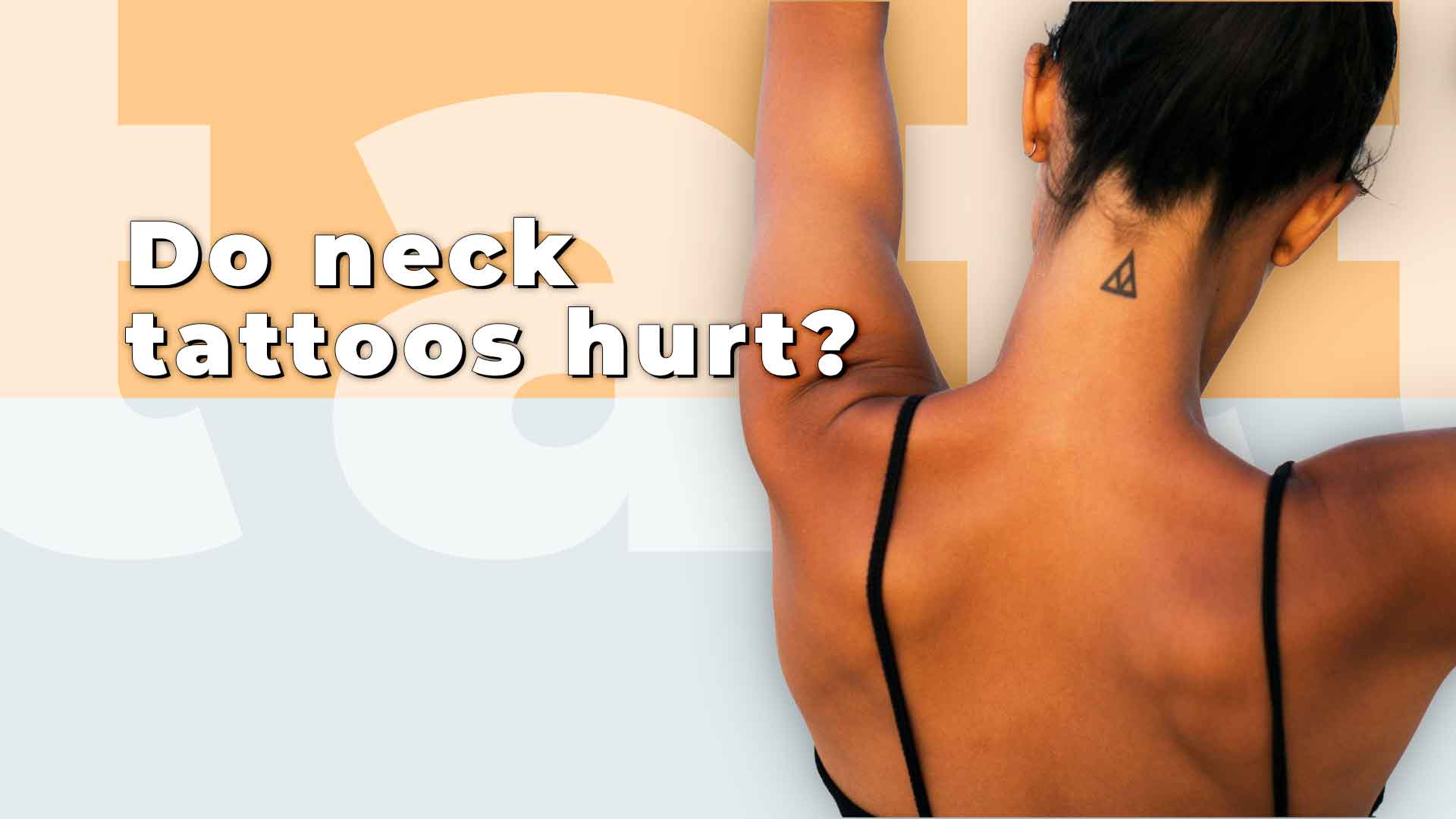Yes, neck tattoos usually hurt more than most placements because the skin in this region is thin, exposed, and close to sensitive nerves. The pain level changes across the neck, with the front feeling the most intense, the side staying moderate, and the back sitting somewhere in between. Understanding these differences helps you choose a placement that matches your tolerance. A neck tattoo often feels like sharp scratching with added vibration that travels through the jaw or ear, especially near bony or hollow areas. Good preparation reduces discomfort, so sleep, hydrate, eat well, and communicate with your artist before the session. Numbing creams can help some people, although results vary. Aftercare becomes essential because the neck moves constantly and faces sunlight, friction, and sweat. Clean the area gently, apply recommended ointment, avoid collars, and protect the tattoo from the sun to support smooth healing and long-lasting clarity.
Table of Contents
ToggleWhy Do Neck Tattoos Hurt?
Neck tattoos hurt because the dermal layers stay thin and lie directly over sensitive structures such as the trachea and carotid region. The cervical plexus creates fast nociceptive signals that move toward the jawline and collarbone. The tattoo machine produces vibration that spreads through neck muscles and generates stinging or buzzing sensations, especially on bony or hollow points where the skin offers minimal resistance.
Do Side Neck Tattoos Hurt?
Side neck tattoos feel moderate for most people because the sternocleidomastoid muscle adds a thin layer of padding. This position avoids many high-density nerve clusters, which keeps the sensation steady rather than overwhelming. People often choose this location for their first neck tattoo since the discomfort remains consistent and easier to handle throughout the session.
Do Front Neck Tattoos Hurt the Most?
Front neck tattoos hurt the most because the skin stays extremely thin over vital structures like the trachea and carotid triangle. This region offers almost no muscle padding, which creates sharp and intense stinging. Many people feel stronger vibration here than in other neck areas, especially during long strokes or color packing.
Do Back Neck Tattoos Hurt?
Back neck tattoos feel moderately painful because the skin remains thin but gains some support from the trapezius muscles. Lower-back areas of the neck feel more tolerable and softer. Upper-back areas near the hairline feel sharper due to tighter skin and proximity to bone. Most people find the pain manageable with small breaks during the session.
Do Neck Tattoos Hurt Behind the Ear?
Behind-the-ear tattoos hurt quite a bit because the skin stays tight and sits directly over bone. Needle vibration often echoes through the skull and creates a concentrated sensation that feels sharp even during short lines. People with low pain tolerance usually find this placement intense since there is no muscle cushioning.
Do Neck Tattoos Hurt More Than Other Tattoos?
Neck tattoos hurt more than tattoos on arms, thighs, or shoulders due to nerve density and thin skin. Neck tattoos hurt less than tattoos on ribs or the spine, where bone exposure increases intensity. Neck tattoos compare closely to hand or foot tattoos, depending on the exact point. These differences reflect bone proximity, skin thickness, and sensory nerve concentration across each area.
Is the Neck a Good Place for a First Tattoo?
The neck is not usually recommended for a first tattoo because it involves high pain, high visibility, and tricky healing. Front placements feel intense and require strong tolerance. Side placements feel manageable but still need careful aftercare due to movement. People often benefit from gaining experience with less sensitive placements before choosing the neck.
What Does a Neck Tattoo Feel Like?
A neck tattoo feels like sharp scratching mixed with steady vibration that travels into the jaw, ear, or back of the head. The front feels stronger because the machine works close to the throat and collarbone. Behind-the-ear spots feel sharper due to tight skin over bone. Many describe the sensation as concentrated stinging that intensifies during long lines or shading.
How Painful Is a Neck Tattoo on a Scale of 1 to 10?
Most people rate neck tattoos between 6 and 9, depending on placement. These variations reflect skin thickness, nerve clusters, and muscle padding. Below is a list of pain levels by area.
- Front Neck (8-9): Thin skin over the trachea makes sensations sharp and intense.
- Side Neck (4-6): The sternocleidomastoid muscle provides mild cushioning and steady sensation.
- Back Neck (6-7): The trapezius adds support, but the upper areas near the hairline feel sharper.
- Behind Ear (7-8): Tight skin over bone creates concentrated, echoing vibration.
Can I Use Numbing Cream for a Neck Tattoo?
Numbing cream can reduce pain during a neck tattoo when applied correctly. Over-the-counter creams containing lidocaine block surface-level signals and help during the outlining phase. The numbing effect slowly fades during shading, which brings mild discomfort back. Results vary across skin types and application methods.
Does Numbing Cream Work for Neck Tattoos?
Numbing cream works when applied 30 to 45 minutes before the session. Artists sometimes notice changes in skin texture or tightness after numbing products, which may affect needle response. Some artists avoid these products due to inconsistent numbing, while others allow them as long as clients communicate clearly and follow instructions.
How Do I Prepare for a Neck Tattoo?
Good preparation makes the session smoother and supports healing. Sleep well to steady nerves. Hydrate well to keep skin elastic. Eat a balanced meal to prevent dizziness or fatigue. Stretch gently to relax the neck. Breathe steadily and communicate with your artist about comfort levels. Moisturize the skin for several days before the appointment to keep it healthy and receptive.
What Should I Expect During a Neck Tattoo Session?
A neck tattoo session includes design confirmation, placement preview, and precise stencil alignment. The artist cleans and shaves the area, adjusts your head position, and begins with slow line work to protect thin skin. The session may include short breaks to reduce stiffness and check swelling. The artist adjusts pressure and angle to maintain clarity without overworking the skin.
How Many Hours Does a Neck Tattoo Take?
Most neck tattoos take 30 minutes to 3 hours depending on size and detail. Fine-line lettering finishes quickly due to minimal shading. Intricate designs with shading or color take longer because the artist works carefully to avoid irritation in sensitive areas. Larger full-side or front pieces may require multiple visits.
How Do I Reduce Neck Tattoo Pain During the Session?
Pain decreases when you use simple techniques that relax your body. Breathe slowly to calm the nervous system. Pause briefly when needed to relieve tension. Distract yourself with music or conversation. Keep your shoulders relaxed and hold a stable posture. Sip water, stretch lightly between breaks, and recenter during longer sessions.
How Do I Care for a Neck Tattoo While It Heals?
Neck tattoos need careful aftercare because this region moves often and stays exposed to sunlight. Clean the area with mild soap, pat it dry gently, and apply a thin layer of recommended ointment. Avoid scratching, rubbing, or soaking. Keep collars, chains, and tight fabrics away from the tattoo. Protect the area from sunlight to prevent early fading or irritation.
How Long Do Neck Tattoos Take to Heal?
Most neck tattoos heal in 2 to 4 weeks when kept clean, moisturized, and protected from friction. The first few days bring tenderness and slight swelling. Week two brings natural flaking and mild itchiness. Proper care reduces the risk of blowouts, irritation, or patchy healing. The skin settles fully over the following weeks with consistent protection.

